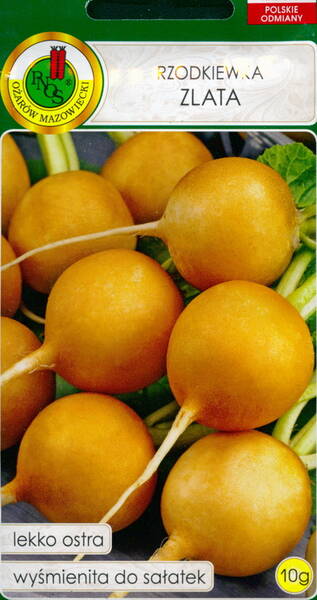A medium-late variety. Harvested in 36-38 days after germination. The radishes are large, round, yellow coloured, do not tend to overgrow.
The flesh is white, juicy. Grows best in light to moderate, non-acid (pH 6-7) soil. 1g contains approximately 70-100 seeds.
Agricultural technology of radish.
It is simple: the seeds are sown dry in the soil to a depth of 1-1.5 cm. With deeper embedding, the roots will be more oval.
Radishes are sown in the spring, immediately after the snow melts.
Radish is a cold-resistant crop, and the use of a shelter when growing it allows you to get an earlier production.
The main mistake of most amateur vegetable growers when sowing radishes is excessive thickening of the seeds. Because of this, the plant is often stretched out and does not produce the required amount of root crops.
It is best to sow radishes one by one at a distance of 5x5 cm.This can be done using a marker, but in order to avoid painstaking work, it can be sown using ribbons with radish seeds attached at a certain distance (this operation can be done independently if they are glued onto strips with a regular newsprint paper with silicate glue).
In Germany, a precision planter is used for sowing radishes, which, depending on the variety, sows seeds in a 10-15 x 3 cm pattern.
Radish grows well at moderate temperatures, from +12 to + 16 ° C. At higher temperatures, the plant grows mainly leaves rather than a root crop.
Radish is sensitive to the length of the day. With a day length of more than 16 hours, the plant does not form a root crop, but proceeds to stem and flowering.
Radish can be grown both as the main crop and as a compactor between the rows of carrots, beets, dill, parsley. While the main culture rises and develops, it will already ripen, and it is easy to remove it from the garden.
Harvesting is carried out as the root crops are formed. Usually they have a diameter of at least 1.5 cm. At the same time, leaf blades are cut off from radishes, which evaporate moisture. Without this technique, the root crop becomes sluggish.
You should not be late in harvesting radish, otherwise, outgrowing, the root crop becomes rough and flabby.
Eng.: Radish. Suom.: Retiisi. Sven.: Rädisa. Bot.: Raphanus sativus L.















